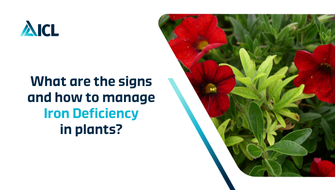Phosphorus (P) is one of the essential macronutrients required for plant growth and development. Phosphorus deficiency in horticulture can have significant impacts on plant health and productivity.
What are the symptoms of Phosphorus Deficiency?
- Stunted Growth: Plants deficient in phosphorus often exhibit reduced growth, resulting in shorter stems and smaller leaves.
- Dark Green or Purplish Leaves: Phosphorus-deficient plants may have leaves that appear dark green or develop a purplish tint, especially on the underside of the leaves.
- Delayed Flowering: Phosphorus deficiency can delay flowering in many plants, which can affect fruit and seed production.
- Reduced Fruit and Seed Production: Phosphorus deficiency can lead to fewer and smaller fruits or seeds. In some cases, fruits may have poor coloration or flavor.
- Poor Root Development: Phosphorus is crucial for root development. Deficient plants may have poorly developed and shallow root systems, which can make them more susceptible to drought stress.
- Leaf Necrosis: In severe cases, phosphorus deficiency can lead to the death of older leaves, which may develop necrotic (dead) spots or edges.

Phosphorus Deficiency in Hypericum
What are the impacts of Phosphorus Deficiency?
- Reduced Crop Yield: The most significant impact of phosphorus deficiency is reduced crop yield. Plants need phosphorus for energy transfer, photosynthesis, and various metabolic processes, all of which are essential for producing healthy fruits, vegetables, and flowers.
- Increased Susceptibility to Diseases and Pests: Weak and stressed plants are more susceptible to diseases and pest infestations. Phosphorus-deficient plants are often less resilient to such challenges.
- Long-term Soil Health Issues: Continuous phosphorus deficiency can deplete phosphorus reserves in the soil, leading to long-term soil health problems. It may require corrective measures to restore soil fertility.

Phosphorus Deficiency in Petunia
How should you manage Phosphorus Deficiency?
- Soil Testing: Start by conducting a soil test to determine the extent of phosphorus deficiency in your horticultural area. This will help you determine the appropriate corrective measures.
- Phosphorus Fertilisation: Correct phosphorus deficiency by applying phosphorus-containing fertilisers such as rock phosphate, superphosphate, or triple superphosphate. The choice of fertiliser depends on the soil pH and the specific needs of the plants you are growing.
- Fertiliser Application Timing: Apply phosphorus-containing fertilisers at the right time. Phosphorus is less mobile in the soil than some other nutrients, so it’s essential to apply it before or during planting to ensure it’s available when the plants need it.
- pH Adjustment: Check and adjust the soil pH if it’s too high or too low. Phosphorus availability is influenced by soil pH. In alkaline soils, phosphorus becomes less available, so lowering the pH may help.
- Organic Matter: Improve soil fertility and phosphorus availability by incorporating organic matter such as compost or well-rotted manure into the soil. Organic matter can also help improve soil structure and water-holding capacity.
- Crop Rotation: Practicing crop rotation can help prevent the depletion of phosphorus in the soil, as different crops have varying nutrient requirements.
- Avoid Overuse: While addressing phosphorus deficiency is important, it’s equally important not to overapply phosphorus fertilisers, as excessive phosphorus can lead to environmental issues like water pollution.

Phosphorus Deficiency in Verbena
Phosphorus deficiency in horticulture is a common issue that can be effectively managed with proper soil testing, fertiliser application, and soil health management practices. Tailor your approach to the specific needs of the plants you are growing and the characteristics of your soil.
0 Brands found
1 Product found
Viewing 0
of 0
No products found, please try removing some filters.
13 Resources found
Viewing of
Want to know more?



Our knowledge
Tips & tricks, disease prevention, crop and market related information
Explore our knowledgeIt looks like you are browsing our site from Australia and New Zealand.
Would you like to visit US website instead?
Yes
No













